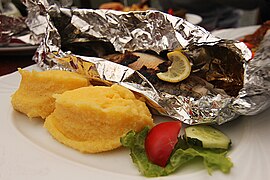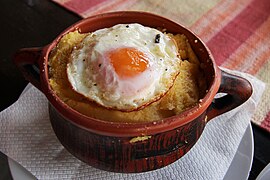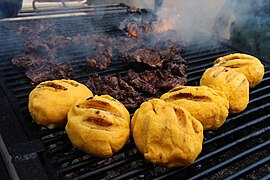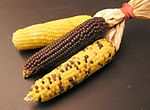Mămăligă
 | |||||||
| Course | Main course | ||||||
|---|---|---|---|---|---|---|---|
| Place of origin | Romania | ||||||
| Region or state | Romania, Moldova, Ukraine | ||||||
| Main ingredients |
| ||||||
| 70 kcal (293 kJ) | |||||||
| |||||||
| Similar dishes |
| ||||||
Mămăligă (Romanian pronunciation: [məməˈliɡə] (![]() listen);) is a porridge made out of yellow maize flour, traditional in Romania, Moldova and West Ukraine. Preparing the traditional dish is also continued by Poles from Lviv whose families were resettled in the Recovered Territories after World War II. In Italy, Portugal, Switzerland, Slovenia, Croatia and many other countries, this dish is known as polenta, while in Georgia, it is called ღომი (gomi).
listen);) is a porridge made out of yellow maize flour, traditional in Romania, Moldova and West Ukraine. Preparing the traditional dish is also continued by Poles from Lviv whose families were resettled in the Recovered Territories after World War II. In Italy, Portugal, Switzerland, Slovenia, Croatia and many other countries, this dish is known as polenta, while in Georgia, it is called ღომი (gomi).
History[]
Historically a peasant food, it was often used as a substitute for bread or even as a staple food in the poor rural areas. However, in the last decades it has emerged as an upscale dish available in the finest restaurants.
Roman influence[]
Historically, porridge is the oldest form of consumption of grains in the whole of humanity, long before the appearance of bread. Originally, the seeds used to prepare slurries were very diverse as millet or einkorn.
Before the introduction of maize in Europe in the 16th century, mămăligă had been made with millet flour, known to the Romans as pulmentum. Moreover, the Romans ate so much of it that the Greeks called them pultiphagonides (porridge eaters).
Corn's introduction in Romania[]
Maize was introduced into Spain by Hernán Cortés from Mexico in 1530 and spread in Europe in the 16th century. Maize (called corn in the United States) requires a good amount of heat and humidity. The Danube Valley is one of Europe's regions ideal for growing maize.
A Hungarian scholar documented the arrival of corn in Timișoara, Banat region, 1692.[3] In Transylvania, maize is also called 'cucuruz',[4] which could imply a connection between Transylvanian and Serbian merchants, kukuruz being a Slavic word.[5] Some assume it was either Șerban Cantacuzino[6][7] or Constantin Mavrocordat[8] who introduced corn in Wallachia, Maria Theresa in Transylvania[9] and Constantine Ducas in Moldavia[8] where it is called păpușoi.[10] Mămăligă of millet would have been replaced gradually by mămăligă made of corn. The corn then become an important food, especially in the fight against famine which prevailed in the 17th and 18th centuries.[11]
Historian Nicolae Iorga noted that farmers of the Romanian Principalities had grown corn since the early-to-mid-17th century.[11]
Etienne Ignace Raicevich, a Republic of Ragusa Ragusan consul of the Napoleonic Empire to Bucharest in the third quarter of the 18th century, wrote that corn was introduced only da poco tempo.
In an edition of Larousse, the French dictionary, in the Danubian principalities, the existence of corn-based mămăligă dates from 1873. mamaligma s. f. Boiled corn meal.
Preparation[]


Traditionally, mămăligă is cooked by boiling water, salt and cornmeal in a special-shaped cast iron pot called ceaun or tuci. When cooked peasant-style and used as a bread substitute, mămăligă is supposed to be much thicker than the regular Italian polenta to the point that it can be cut in slices, like bread. When cooked for other purposes, mămăligă can be much softer, sometimes almost to the consistency of porridge. Because mămăligă sticks to metal surfaces, a piece of sewing thread is used to cut it into slices instead of a knife; it can then be eaten by holding it with the hand, just like bread.
Mămăligă is a versatile food: various recipes of mămăligă-based dishes may include milk, butter, various types of cheese, eggs, sausages (usually fried, grilled or oven-roasted), bacon, mushrooms, ham, fish etc. Mămăligă is a fat-free, cholesterol-free, high-fiber food. It can be used as a healthy alternative to more refined carbohydrates such as white bread, pasta or hulled rice.
Serving mămăligă[]
Mămăligă is often served with sour cream and cheese on the side (mămăligă cu brânză și smântână) or crushed in a bowl of hot milk (mămăligă cu lapte). Sometimes slices of mămăligă are pan-fried in oil or in lard, the result being a sort of corn pone.
Also, the traditional meal is served with meat, usually pork called "tocana" or fried fish and "mujdei" (a mix of oil and garlic)
Similar dishes[]
Since mămăligă can be used as an alternative for bread in many Romanian and Moldovan dishes, there are quite a few which are either based on mămăligă, or include it as an ingredient or side dish. Arguably, the most popular of them is sarmale (a type of cabbage roll) with mămăligă.
Another very popular Romanian dish based on mămăligă is called bulz, and consists of mămăligă with cheese and butter and roasted in the oven.

(sometimes spelled ) is another mămăligă-like traditional Romanian dish, but is more elaborate. Unlike mămăligă (where the cornmeal is boiled in water) when making balmoș the cornmeal must be boiled in sheep milk. Other ingredients, such as butter, sour cream, telemea (a type of feta cheese), caș (a type of fresh curdled without whey, which is sometimes called "green cheese" in English), urdă (similar to ricotta), etc., are added to the mixture at certain times during the cooking process. It is a specialty dish of old Romanian shepherds, and nowadays very few people still know how to make a proper balmoș.
Trivia[]
- A gruel made of cornmeal, water, milk, butter, salt and sugar is called in Romanian cir de mămăligă. If it is exceedingly thin and made only of cornmeal, water and salt it is called mieșniță or terci.
- Depending on the context, mălai is the Romanian word for either:
- The Romanian version of cornmeal
- Any type of cereals or edible grains (much like the English corn), but this use of the word is becoming increasingly obsolete
- Corn flour (i.e., maize flour) is called in Romanian mălai or făină de porumb.
- Before the arrival of maize in Eastern Europe, mămăligă was made of millet flour, but nowadays millet mămăligă is no longer made.
- Mămăligă is mentioned multiple times in Aaron Lebedeff's Yiddish novelty song Rumania, Rumania.[12] In Yiddish it is spelled מאַמאַליגע.
In literature[]
In Chapter One of Dracula by Bram Stoker is the commentary, "I had for breakfast more paprika, and a sort of porridge of maize flour which they said was ‘mamaliga’, and egg-plant stuffed with forcemeat, a very excellent dish, which they call ‘impletata’”.
Similar dishes[]
Mămăligă is similar to the Italian polenta,[13] which is also very popular in Brazil.
Cornmeal mush is its analogue common in some regions of the United States and grits in the southern regions.
Its analogue in Serbia and Bulgaria is called kačamak (Serbian: качамак/kačamak), (Bulgarian: качамак) and is served mainly with white brine cheese or fried pieces of pork fat with parts of the skin.
In Bosnia and Herzegovina, Croatia (also polenta or palenta), Serbia (also kačamak) and in Montenegro the dish is mainly called pura. In North Macedonia it is called bakrdan (Macedonian: бакрдан) and in Slovenia polenta. In Hungary it is called puliszka.
In Turkey a similar dish, called kuymak or muhlama, is among the typical dishes of the Black Sea Region, although now popular in all the greater cities where there are many regional restaurants.
Broccoliga is a variant of Mămăligă featuring a broccoli-polenta mixture suffused with cheddar cheese and herbs.
Known by different names in local languages (Abkhazian: абысҭа abysta, Adyghe: мамрыс mamrys, Georgian: ღომი ghomi, Ingush: журан-худар zhuran-khudar, Chechen: ah'ar-hudar/zhuran-hudar, Nogai: мамырза mamyrza, Ossetian: дзыкка dzykka or сера sera), it is also widespread in Caucasian cuisines.
There is also a distinct similarity to cou-cou (as it is known in the Barbados), or fungi (as it is known in Antigua and Barbuda and other Leeward Islands in the Caribbean Sea).
This dish is eaten widely across Africa, often with white maize flour instead of yellow, where it has different local names:
- Akamu – Igbo, Nigeria
- Arega - Kenya, Luo
- Bando - Soga, Uganda
- Bidia – DR Congo[14]
- Bogobe/Phaletšhe – Botswana, South Africa
- Bugali – Burundi, DR Congo, Sudan, South Sudan Rwanda
- Buhobe – Lozi[15]
- Buru – Kenya, Luo
- Busima-Bagisu, Uganda
- Chenge – Kenya, Luo
- Chima – Mozambique
- Couscous de Cameroon – Cameroon
- Dona
- Fitah - Sudan, South Sudan, Congo
- Fufu - Sierra Leone
- Isitshwala – Botswana, Ndebele
- Kawunga - Ganda, Uganda
- Kimnyet – Kalenjin, Kenya
- Kuon – Kenya, Luo
- Kwen wunga - Alur, Uganda
- Lipalishi – Eswatini
- Mielie pap – Lesotho,[14] South Africa[14][16]
- Mogo – Kenya, Luo
- Moteke – DR Congo[14]
- Mutuku – South Africa[14]
- Nfundi – Congo[14]
- Ngima – Kamba, Kenya, Kikuyu
- Nkima – Kenya, Meru
- Nshima- DR Congo Kasai region
- Nsima – Malawi,[14] Zambia[14]
- Obusuma – Kenya, Nyole[17]
- Ogi – Nigeria, Yoruba
- Oshifima – Namibia
- Pap – Namibia, South Africa[18]
- Papa – Lesotho,[14] South Africa[14]
- Phaletšhe – Botswana
- Phuthu – South Africa[19]
- Posho – Uganda[20]
- Poshto – Uganda
- Saab – Ghana, Kusasi
- Sadza – Shona and Kalanga, Zimbabwe and Botswana[14][21]
- Sakora – Nigeria
- Sakoro – Ghana
- Sembe - Tanzania, slang
- Sembe – Kenya, slang
- Shadza – Kalanga, Botswana
- Shima
- Shishima - Zambia
- Sima – Chewa,[22] Tumbuka, and Ngoni[15]
- Soor – Somalia,[14] Zambia[14]
- Tuozafi (or T.Z.) – Ghana
- Ubugali – Rwanda
- Ubwali – Bemba[15]
- Ugali – Kenya,[14] Malawi, Mozambique, Tanzania,[14] Uganda,[14] Yao, Swahili
- Um'ratha – Ndebele
- Upswa – Mozambique[14]
- Vbogobe – Sotho, Tswana
- Vhuswa – Venda
- Xima – Mozambique[14]
Gallery[]

Mămăligă with pork rind, bryndza and sour cream

Mămăligă with a spoonful of sour cream and sarmale

Mămăligă and trout wrapped in tinfoil

Moldavian tochitură with mămăligă, cheese and egg

Bulz with egg

See also[]
- Bulz
- Cocoloși
- Cornbread
- List of maize dishes
- List of porridges
- Tocană – a Romanian stew traditionally served with mămăligă
References[]
- ^ "Mămăliga, o alternativă sănătoasă cu mai puţine calorii decât pâinea!". Ce se întâmplă Doctore? (in Romanian). 3 December 2014.
- ^ "Calorii mamaliga". Calorii.oneden.com. Retrieved 11 April 2018.
- ^ "Le maïs arrive dans les Balkans" (in French). Georges C. Haupt.
- ^ "Maghiarii din Ardeal, indiferenti la Kosovo: Sadim cucuruz si vin mistretii de-l mananca. No, asta e problema noastra!". Hotnews.ro. Retrieved 11 April 2018.
- ^ "CUCURUZ - Definiția din dicționar - Resurse lingvistice". Archeus.ro. Retrieved 11 April 2018.
- ^ [1][dead link]
- ^ "Archived copy". Archived from the original on 2017-05-11. Retrieved 2018-02-10.CS1 maint: archived copy as title (link)
- ^ Jump up to: a b "Free-referate.ro". Free-referate.ro. Archived from the original on 2014-02-02. Retrieved 11 April 2018.
- ^ [2][dead link]
- ^ "dexonline". Dexonline.ro. Retrieved 11 April 2018.
- ^ Jump up to: a b "L'introduction des plantes du Nouveau Monde dans les cuisines régionales" (PDF). Philippe Marchenay, Jacques Barrau, Laurence Bérard.
- ^ "Rumania, Rumania!". Yiddish Songs and Lyrics.
- ^ "Coming up: Food from the new EU". BBC News. January 1, 2007. Retrieved 30 October 2013.
- ^ Jump up to: a b c d e f g h i j k l m n o p q r McCann, James C. (2009). Stirring the Pot: A History of African Cuisine. Athens, Ohio: Ohio University Press. p. 137. ISBN 9780896802728.
- ^ Jump up to: a b c Tembo, Mwizenge S. "Nshima and Ndiwo: Zambian Staple Food". Hunger For Culture. Archived from the original on 24 February 2017. Retrieved 2018-02-18.
- ^ "Mealiepap, n." Dictionary of South African English. Dictionary Unit for South African English, 2018.[3] 25 February 2019
- ^ "Kenya Information Guide Home page". Retrieved 24 June 2013.
- ^ "Pap, n." Dictionary of South African English. Dictionary Unit for South African English, 2018. [4] 25 February 2019.
- ^ "Putu, n." Dictionary of South African English. Dictionary Unit for South African English, 2018.[5] 25 February 2019.
- ^ "Ugandan food recipes - POSHO (UGALI) - Wattpad". www.wattpad.com. Retrieved 2018-08-23.
- ^ "Sadza, n." Dictionary of South African English. Dictionary Unit for South African English, 2018. [6] 25 February 2019
- ^ Gough, Amy (2004). "The Chewa". The Peoples of The World Foundation. Retrieved 18 February 2018.
External links[]
 Media related to Mamaliga at Wikimedia Commons
Media related to Mamaliga at Wikimedia Commons
- Moldovan dishes
- Porridges
- Romanian dishes
- Staple foods
- Maize dishes
- National dishes
- Peasant food







